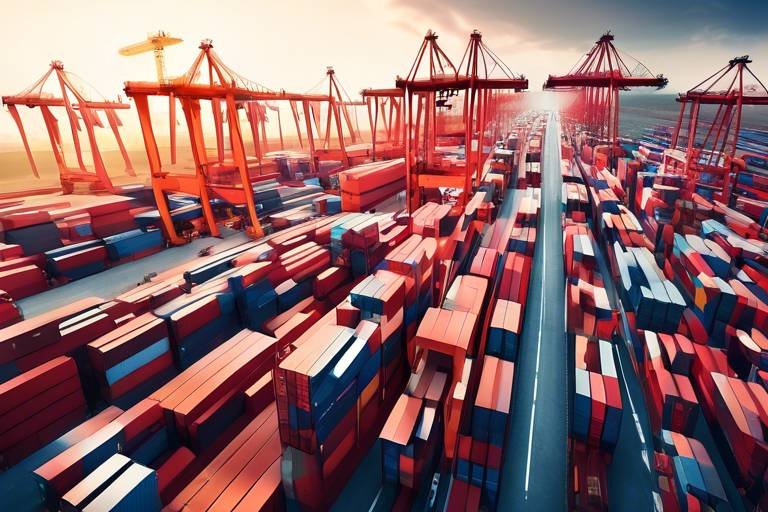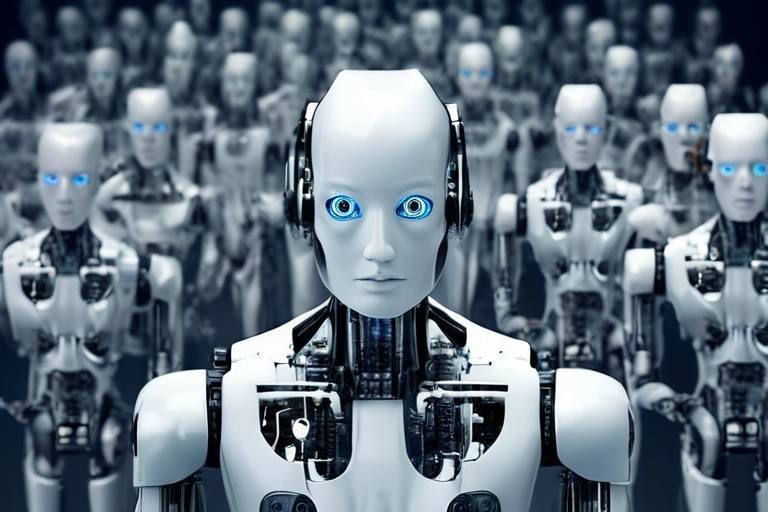Addressing Climate Change with AI
In an era where climate change poses a significant threat to our planet, the integration of artificial intelligence (AI) into environmental strategies has emerged as a beacon of hope. Imagine a world where technology and nature work hand in hand, where algorithms and data analytics pave the way for sustainable solutions. This article delves into the transformative power of AI in combating climate change, showcasing innovative strategies that not only enhance sustainability but also protect our fragile ecosystems. From improving climate modeling to optimizing renewable energy sources, AI is revolutionizing how we approach environmental challenges. So, how exactly can AI help us in this fight against climate change? Let’s dive deeper into the fascinating intersection of technology and environmental stewardship.
One of the most significant contributions of AI to climate change mitigation is its ability to enhance climate modeling. Traditional climate models often struggle with the sheer volume of data generated by environmental systems. However, AI excels at processing vast datasets, enabling researchers to improve accuracy and predict future climate scenarios with greater precision. By utilizing machine learning algorithms, scientists can analyze patterns and trends that were previously undetectable, allowing for better-informed decisions by policymakers and stakeholders. This advanced modeling capability not only helps us understand the current state of our climate but also equips us with the tools to forecast potential outcomes and devise effective strategies to combat adverse effects.
As the world shifts towards renewable energy sources, AI technologies play a pivotal role in optimizing these resources, particularly solar and wind energy. By analyzing data from various sources, AI can improve efficiency in energy production and distribution, significantly reducing our reliance on fossil fuels. For instance, AI systems can predict energy generation based on weather forecasts, allowing for better integration of renewable sources into the energy grid.
AI-driven smart grids are revolutionizing how we manage energy resources. These systems enable real-time monitoring and management, facilitating the integration of renewable energy while enhancing grid reliability. Imagine a network where energy flows seamlessly, adjusting to demand fluctuations and ensuring that every kilowatt is utilized efficiently. With AI, this vision is becoming a reality, leading to a more resilient energy infrastructure.
Moreover, AI can implement demand response systems that adjust energy consumption based on real-time data. This dynamic approach helps to balance supply and demand efficiently, reducing the strain on energy systems during peak hours. By encouraging consumers to shift their energy use to off-peak times, we can minimize the need for additional power plants and lower greenhouse gas emissions.
Another fascinating application of AI is in the predictive maintenance of energy infrastructure. By analyzing data from sensors and equipment, AI can identify potential failures before they occur, prolonging the lifespan of energy systems. This proactive approach not only reduces downtime but also minimizes environmental impacts, as fewer resources are wasted on repairs and replacements.
AI also plays a crucial role in analyzing energy consumption patterns. By providing insights into how businesses and individuals use energy, AI helps identify opportunities to reduce carbon footprints and optimize usage. With this information, stakeholders can make informed decisions that lead to significant environmental benefits.
AI supports a variety of climate change mitigation strategies, from carbon capture technology to sustainable agriculture practices. By enhancing efforts to reduce greenhouse gas emissions, AI is crucial in our fight against climate change.
For instance, AI significantly improves the development of carbon sequestration technologies, which are essential for capturing and storing carbon emissions from industrial processes. By optimizing these technologies, we can effectively reduce the amount of carbon dioxide released into the atmosphere, contributing to a healthier planet.
Additionally, AI-driven precision agriculture optimizes resource use, reduces waste, and enhances crop yields. This approach not only contributes to food security but also minimizes environmental impact, showcasing how technology can lead to sustainable farming practices.
AI also aids in climate adaptation efforts by providing tools for risk assessment, resource management, and infrastructure resilience. As communities prepare for climate-related challenges, AI can offer critical support.
For example, AI systems improve disaster response by analyzing data to predict and manage climate-related disasters. This capability facilitates faster recovery and more efficient resource allocation, ensuring that communities can bounce back more quickly after adverse events.
Furthermore, AI optimizes water resource management through predictive analytics, ensuring sustainable use of water in agriculture, urban planning, and conservation efforts. As water scarcity becomes an increasingly pressing issue, AI's role in managing this vital resource cannot be overstated.
While the benefits of AI in addressing climate change are significant, it is crucial to acknowledge the challenges and ethical considerations that accompany its implementation. Issues such as data privacy, algorithmic bias, and the environmental impact of AI technologies themselves must be carefully navigated.
The use of AI in climate initiatives raises concerns about data privacy, necessitating robust frameworks to protect sensitive information while leveraging data for environmental benefits. Striking a balance between innovation and privacy is essential to ensure public trust.
Moreover, addressing algorithmic bias is crucial to ensuring equitable outcomes in AI applications for climate change. Biased data can lead to skewed results and ineffective solutions, ultimately hindering progress in our efforts to combat climate change.
- How does AI improve climate modeling? AI processes large datasets to enhance the accuracy of climate predictions, enabling better decision-making.
- Can AI help reduce energy consumption? Yes, AI analyzes consumption patterns to provide insights that help individuals and businesses optimize their energy use.
- What are the ethical concerns surrounding AI in climate change? Key concerns include data privacy, algorithmic bias, and the environmental impact of AI technologies.

AI's Role in Climate Modeling
Artificial intelligence is revolutionizing the way we approach climate modeling, acting as a powerful tool to process and analyze vast datasets that would otherwise be overwhelming for human researchers. Imagine trying to solve a complex puzzle with thousands of pieces; AI not only helps to sort these pieces but also predicts how they fit together to create a clearer picture of our planet's future. By leveraging machine learning algorithms, AI enhances the accuracy of climate models, enabling scientists to simulate various scenarios and understand potential outcomes based on different variables.
One of the significant advantages of AI in climate modeling is its ability to analyze historical climate data alongside real-time information. This dynamic analysis allows for better predictions of future climate conditions, which is essential for policymakers and stakeholders who need to make informed decisions. For example, AI can identify patterns in temperature changes, precipitation levels, and extreme weather events, providing insights that are crucial for developing effective climate strategies.
Furthermore, the integration of AI into climate modeling can lead to the development of more localized models. Traditional climate models often rely on broad geographical data, which may not accurately reflect the unique climatic conditions of specific regions. AI can process local data, such as geographic features and human activities, to create tailored models that offer a more precise understanding of climate impacts at the community level. This localized approach is vital for effective resource management and disaster preparedness.
To illustrate the impact of AI in climate modeling, consider the following table that highlights key AI applications and their benefits:
| AI Application | Description | Benefits |
|---|---|---|
| Data Processing | Analyzing large datasets from satellites and sensors. | Improved accuracy in climate predictions. |
| Scenario Simulation | Modeling various climate scenarios based on different variables. | Better understanding of potential future impacts. |
| Localized Modeling | Creating models that reflect regional climatic conditions. | Enhanced resource management and disaster preparedness. |
AI's ability to continuously learn and adapt makes it an invaluable asset in climate research. As new data becomes available, AI systems can recalibrate and refine their models, ensuring that predictions remain relevant and accurate. This adaptability is crucial in a world where climate change is an ever-evolving challenge, requiring constant vigilance and updates to our understanding and strategies.
In conclusion, the role of AI in climate modeling is not just a technological advancement; it's a necessary evolution in our fight against climate change. By improving the precision of climate predictions and enabling better decision-making, AI empowers us to take proactive steps toward sustainability and environmental protection. The future of our planet may very well depend on how effectively we harness the power of artificial intelligence in this crucial area.
- How does AI improve climate modeling? AI enhances climate modeling by processing large datasets quickly and accurately, allowing for better predictions and localized models.
- What are the benefits of localized climate models? Localized models provide more precise insights into specific regions, aiding in effective resource management and disaster preparedness.
- Can AI adapt to new climate data? Yes, AI systems can continuously learn and adjust their models based on new data, ensuring predictions remain relevant.

AI for Renewable Energy Optimization
In today's world, where climate change looms large, the urgency to transition to renewable energy sources has never been more pressing. Enter artificial intelligence (AI), a game-changer in the quest for optimizing renewable energy production. By harnessing the power of AI, we can significantly enhance the efficiency of energy systems, making renewable sources like solar and wind not just viable alternatives, but the backbone of our energy infrastructure.
One of the most exciting aspects of AI in renewable energy is its ability to analyze and process vast amounts of data. Imagine a world where energy consumption patterns are predicted with precision, allowing for adjustments in real-time. This is where AI shines, as it can sift through historical data, weather patterns, and energy demand forecasts to optimize energy production. For instance, AI algorithms can predict when solar panels will generate the most energy based on sunlight exposure, helping to maximize output and reduce waste.
At the heart of renewable energy optimization is the concept of smart grids. These advanced energy systems use AI to facilitate real-time monitoring and management of energy resources. With smart grids, energy providers can dynamically adjust the distribution of electricity based on current demand and supply conditions. This not only enhances grid reliability but also allows for a seamless integration of renewable energy sources into the existing infrastructure.
Consider this: without smart grid technology, energy companies might struggle to manage the fluctuations that come with renewable sources. For example, if a storm clouds the sky, solar energy production may drop suddenly. AI can help predict these dips and adjust the energy supply accordingly, ensuring that consumers always have access to the power they need.
Another significant innovation brought about by AI is the implementation of demand response systems. These systems use real-time data to adjust energy consumption across different sectors, ensuring that supply and demand are always in harmony. For instance, during peak hours when energy demand skyrockets, AI can signal large consumers, like factories, to reduce their usage temporarily. This not only prevents blackouts but also minimizes the need for fossil fuel backup generation, thus reducing carbon emissions.
AI also plays a critical role in the predictive maintenance of energy infrastructure. By analyzing data from sensors placed on wind turbines or solar panels, AI can predict when equipment is likely to fail or require maintenance. This proactive approach not only prolongs the lifespan of energy assets but also reduces downtime and minimizes the environmental impact associated with repairs and replacements.
In summary, the integration of AI into renewable energy optimization is transforming how we produce, distribute, and consume energy. By leveraging AI technologies, we can not only enhance efficiency but also pave the way for a sustainable energy future. As we continue to innovate and adopt these technologies, the dream of a cleaner, greener planet becomes more attainable.
- How does AI improve renewable energy efficiency? AI analyzes large datasets to optimize energy production and distribution, ensuring renewable sources are used effectively.
- What are smart grids? Smart grids are advanced energy systems that use AI for real-time monitoring and management of energy resources, enhancing reliability and integrating renewable sources.
- Can AI predict energy demand? Yes, AI can predict energy demand using historical data and real-time analytics, allowing for better energy management.
- What is predictive maintenance? Predictive maintenance uses AI to analyze equipment data and predict failures, helping to extend the lifespan of energy infrastructure.

Smart Grid Management
In the world of energy, is like having a conductor leading an orchestra, ensuring that every instrument plays in harmony. This innovative approach combines traditional energy systems with cutting-edge technology to create a network that is not only efficient but also responsive to the needs of consumers and the environment. Imagine a grid that can communicate, learn, and adapt in real-time—this is the essence of smart grid management.
At its core, smart grid management leverages artificial intelligence to monitor and control energy resources seamlessly. By analyzing vast amounts of data from various sources, AI can predict energy demand, identify potential outages, and optimize the distribution of electricity. This not only enhances the reliability of the power supply but also facilitates the integration of renewable energy sources, such as solar and wind, into the grid. The result? A more sustainable energy future that reduces our reliance on fossil fuels.
One of the standout features of smart grids is their ability to implement demand response systems. These systems adjust energy consumption based on real-time data, allowing consumers to shift their usage to off-peak hours when energy is cheaper and more abundant. For example, during a hot summer day, when everyone cranks up their air conditioning, the smart grid can incentivize users to reduce their consumption, preventing blackouts and ensuring a stable energy supply. It's like having a personal energy assistant that helps you save money while contributing to a greener planet.
Moreover, AI-driven smart grid management enhances the predictive maintenance of energy infrastructure. By using machine learning algorithms, utilities can analyze data from sensors installed on equipment to predict when maintenance is needed, thus prolonging the lifespan of critical infrastructure. This proactive approach minimizes downtime and reduces environmental impacts, as fewer resources are wasted on repairs and replacements. It's akin to taking your car for regular check-ups to ensure it runs smoothly and efficiently, rather than waiting for it to break down on the highway.
To illustrate the impact of smart grid management, consider the following table that highlights the key benefits:
| Benefit | Description |
|---|---|
| Enhanced Reliability | Real-time monitoring prevents outages and ensures a stable energy supply. |
| Integration of Renewables | Facilitates the use of solar and wind energy, reducing fossil fuel dependency. |
| Cost Savings | Demand response systems lower energy costs for consumers and utilities. |
| Environmental Impact | Reduces greenhouse gas emissions and promotes sustainable practices. |
In conclusion, smart grid management represents a significant leap towards a sustainable energy future. By harnessing the power of AI, we can create an energy system that not only meets our current needs but also safeguards the environment for generations to come. As we continue to innovate and improve our energy infrastructure, the role of smart grids will only become more critical in our fight against climate change.
- What is a smart grid? A smart grid is an electricity supply network that uses digital technology to monitor and manage the transport of electricity from all generation sources to meet the varying electricity demands of end users.
- How does AI improve smart grid management? AI enhances smart grid management by analyzing data in real-time, predicting energy demand, and optimizing the distribution of electricity, leading to increased efficiency and reliability.
- What are the benefits of demand response systems? Demand response systems help balance energy supply and demand, reduce energy costs for consumers, and prevent outages during peak usage times.
- Can smart grids integrate renewable energy sources? Yes, smart grids are designed to facilitate the integration of renewable energy sources, improving their efficiency and reliability within the overall energy system.

Demand Response Systems
Demand response systems represent a revolutionary approach to energy management that leverages the power of artificial intelligence to create a more efficient and responsive energy grid. Imagine a world where your energy consumption is dynamically adjusted in real-time, ensuring that supply meets demand without any waste. This is not just a dream—it's a reality made possible by AI technology. By analyzing data from various sources, these systems can predict peak demand times and automatically adjust energy usage accordingly, which ultimately leads to significant cost savings and a reduced carbon footprint.
At the heart of demand response systems is the ability to communicate with smart appliances, industrial equipment, and even entire buildings. When energy demand surges, these systems can temporarily reduce power consumption in non-essential areas, allowing critical services to continue operating without interruption. For instance, during a hot summer day, air conditioning units in commercial buildings can be programmed to lower their output slightly, alleviating pressure on the grid while still maintaining a comfortable environment for employees and customers.
Moreover, demand response systems are not only beneficial for energy providers but also for consumers. By participating in these programs, households and businesses can take advantage of lower energy rates during off-peak hours. This creates a win-win situation where consumers save money, and energy providers can manage their resources more efficiently. The integration of AI into these systems allows for more precise forecasting and real-time adjustments, making them an indispensable tool in the fight against climate change.
However, implementing demand response systems is not without its challenges. There are concerns regarding the reliability of technology, potential disruptions in service, and the need for widespread consumer education. To address these issues, stakeholders must work collaboratively to develop robust frameworks that ensure the smooth operation of demand response systems while also protecting consumer interests. This includes creating incentives for participation and ensuring that the technology is accessible and user-friendly.
In conclusion, demand response systems powered by AI are transforming the way energy is consumed and managed. By enabling real-time adjustments to energy usage, these systems help to balance supply and demand efficiently, reduce reliance on fossil fuels, and contribute significantly to sustainability efforts. As we move forward, the continued development and implementation of these systems will be crucial in our fight against climate change, paving the way for a greener and more sustainable future.
- What are demand response systems?
Demand response systems are technology-driven solutions that adjust energy consumption in real-time to match supply and demand, helping to reduce energy costs and environmental impact. - How does AI enhance demand response?
AI enhances demand response by analyzing vast amounts of data to predict energy usage patterns and optimize energy distribution, allowing for more efficient energy management. - Can consumers benefit from demand response programs?
Yes, consumers can benefit from lower energy rates during off-peak hours by participating in demand response programs, leading to significant cost savings. - What challenges do demand response systems face?
Challenges include technology reliability, potential service disruptions, and the need for consumer education to ensure widespread participation.

Predictive Maintenance of Energy Infrastructure
Predictive maintenance of energy infrastructure represents a transformative approach to ensuring the longevity and efficiency of energy systems. By leveraging artificial intelligence (AI), energy providers can proactively address potential failures before they escalate into costly outages or repairs. Imagine a world where energy grids are not just reactive but predictive, catching issues before they disrupt power supply. This is the promise of predictive maintenance, and it’s already making waves in the energy sector.
At its core, predictive maintenance utilizes data analytics and machine learning algorithms to analyze historical and real-time data from various energy assets. These assets can range from wind turbines to solar panels and traditional power plants. By continuously monitoring equipment performance, AI systems can identify patterns and anomalies that may indicate impending failures. This proactive strategy not only minimizes downtime but also significantly reduces maintenance costs, leading to more sustainable energy production.
For instance, consider a scenario where an AI system detects unusual vibrations in a wind turbine. Instead of waiting for a scheduled maintenance check, the system can alert technicians to investigate the issue immediately. This early intervention can prevent catastrophic failures, ensuring that the turbine remains operational and continues to generate energy efficiently.
Moreover, predictive maintenance also contributes to environmental sustainability. By maintaining energy infrastructure more effectively, we can reduce waste and minimize the environmental impact associated with repairs and replacements. Not only does this approach enhance the reliability of energy sources, but it also aligns with global efforts to combat climate change. In fact, a recent study indicated that predictive maintenance could reduce maintenance costs by up to 25% and extend the lifespan of energy assets by 20%.
To illustrate the benefits of predictive maintenance, consider the following table that summarizes the key advantages and impacts of implementing AI-driven predictive maintenance in energy infrastructure:
| Advantage | Impact |
|---|---|
| Reduced Downtime | Minimizes service interruptions and enhances reliability. |
| Cost Savings | Reduces maintenance costs by identifying issues early. |
| Extended Asset Lifespan | Increases the operational life of energy infrastructure. |
| Environmental Benefits | Less waste and reduced carbon footprint from fewer repairs. |
In conclusion, predictive maintenance of energy infrastructure is not just a technological advancement; it is a necessary evolution in how we manage our energy resources. By embracing AI-driven solutions, we can create a more resilient, efficient, and sustainable energy landscape. The future of energy management is here, and it’s powered by predictive analytics.
- What is predictive maintenance?
Predictive maintenance is a proactive approach that uses data analytics and AI to predict when equipment failures might occur, allowing for timely interventions.
- How does AI improve predictive maintenance?
AI enhances predictive maintenance by analyzing vast amounts of data in real-time, identifying patterns, and predicting potential failures before they happen.
- What are the benefits of predictive maintenance in energy infrastructure?
Benefits include reduced downtime, lower maintenance costs, extended asset lifespan, and environmental sustainability.
- Can predictive maintenance help combat climate change?
Yes, by improving the efficiency and reliability of energy systems, predictive maintenance can contribute to reduced carbon emissions and a smaller environmental footprint.

Energy Consumption Analytics
In today's world, where energy consumption is a pressing concern, AI-driven analytics has emerged as a game changer. By harnessing the power of artificial intelligence, we can dissect complex energy usage patterns that were once too intricate for human analysis. Imagine having a digital assistant that not only tracks your energy consumption but also provides actionable insights to cut costs and reduce your carbon footprint. Sounds like something out of a sci-fi movie, right? But it's happening now, and it's transforming how we think about energy.
AI algorithms analyze data from various sources, including smart meters, IoT devices, and even social media trends, to create a comprehensive picture of energy usage. This analysis can identify peak consumption times, uncover inefficiencies, and suggest optimal usage patterns. For instance, businesses can leverage these insights to shift heavy energy-consuming processes to off-peak hours, thereby saving money and reducing strain on the grid.
One of the most exciting aspects of energy consumption analytics is its potential for personalization. With AI, we can tailor energy plans that fit individual needs. Imagine receiving a monthly report that not only details your energy consumption but also recommends specific changes based on your lifestyle. This level of personalization can lead to significant reductions in energy waste. For example, if an AI system detects that you're using more energy during certain hours, it might suggest adjusting your habits or even installing smart devices that automate energy-saving measures.
Moreover, energy consumption analytics can play a pivotal role in sustainability efforts. By providing businesses and individuals with clear insights into their energy use, AI encourages more responsible consumption. It can also highlight the impact of renewable energy sources, allowing users to see how much cleaner energy they are using compared to traditional fossil fuels. This transparency fosters a sense of accountability and motivates users to adopt greener practices.
However, the implementation of AI in energy analytics isn't without its challenges. Data privacy is a major concern, as the collection and analysis of personal energy usage data raise questions about how this information is stored and utilized. To address this, it's crucial to establish strong data protection frameworks that ensure users feel secure while benefiting from AI technologies.
To illustrate the impact of energy consumption analytics, consider the following table that highlights key benefits:
| Benefit | Description |
|---|---|
| Cost Savings | Identifies peak usage times and suggests optimal energy usage to reduce bills. |
| Environmental Impact | Encourages the use of renewable energy and reduces reliance on fossil fuels. |
| Personalization | Offers customized energy plans based on individual consumption patterns. |
| Efficiency Improvements | Highlights inefficiencies and suggests improvements in energy usage. |
In conclusion, AI-driven energy consumption analytics is not just a trend; it's a necessary evolution in how we manage energy. By embracing these technologies, we can create a more sustainable future, reduce costs, and empower individuals and businesses to make informed decisions about their energy use. As we move forward, the integration of AI into our daily lives will continue to reveal new opportunities for enhancing energy efficiency and environmental stewardship.
- What is energy consumption analytics? Energy consumption analytics refers to the use of AI and data analysis to understand and optimize energy usage patterns.
- How can AI help reduce energy costs? AI can identify peak usage times and suggest optimal energy consumption strategies, leading to cost savings.
- Are there privacy concerns with energy analytics? Yes, the collection of personal energy data raises privacy issues, necessitating robust data protection measures.
- Can individuals benefit from energy consumption analytics? Absolutely! Individuals can receive tailored insights that help them reduce energy waste and save money.

AI in Climate Change Mitigation Strategies
Artificial Intelligence (AI) is emerging as a powerful ally in the fight against climate change, offering innovative solutions that can significantly reduce greenhouse gas emissions. By harnessing the capabilities of AI, we can develop smarter strategies for climate change mitigation. One of the most compelling aspects of AI is its ability to analyze vast amounts of data quickly and accurately, enabling us to make informed decisions that can lead to more sustainable practices.
For instance, AI plays a crucial role in enhancing carbon capture technologies. These technologies aim to capture carbon dioxide emissions produced from industrial processes and store them underground or repurpose them for other uses. With AI's assistance, researchers can optimize the efficiency of these systems, ensuring that they operate at maximum capacity while minimizing energy consumption. This not only helps in reducing the overall carbon footprint but also contributes to a more sustainable industrial sector.
Moreover, sustainable agriculture practices are being revolutionized through AI-driven precision agriculture. This approach utilizes data analytics, machine learning, and IoT (Internet of Things) devices to optimize resource use in farming. By analyzing soil conditions, weather patterns, and crop health, AI can provide farmers with actionable insights that lead to:
- Reduced water usage through targeted irrigation systems.
- Minimized chemical inputs by applying fertilizers and pesticides only when necessary.
- Enhanced crop yields through better resource management and planning.
These advancements not only contribute to food security but also help in minimizing the environmental impact of agriculture, which is a significant contributor to greenhouse gas emissions. As we look toward the future, the integration of AI in these sectors promises to transform how we approach climate change mitigation.
However, it's essential to recognize that while AI offers remarkable potential, it should be implemented thoughtfully. The development of AI technologies must be accompanied by rigorous assessments to ensure they align with sustainability goals. This involves evaluating not just the effectiveness of these technologies but also their social and environmental impacts.
In conclusion, AI is a game-changer in the realm of climate change mitigation strategies. By enhancing carbon capture technologies and promoting sustainable agricultural practices, AI can help us navigate the challenges posed by climate change more effectively. As we continue to innovate and integrate AI into our environmental strategies, we must remain vigilant about the ethical implications and ensure that our solutions are equitable and just.
Q1: How does AI help in carbon capture technologies?
A1: AI enhances carbon capture technologies by optimizing their efficiency, allowing for better monitoring and management of emissions, which leads to more effective carbon sequestration.
Q2: What is precision agriculture, and how does AI contribute to it?
A2: Precision agriculture uses AI to analyze data from various sources to optimize farming practices. This includes improving water usage, reducing chemical inputs, and maximizing crop yields.
Q3: Are there any risks associated with using AI for climate change mitigation?
A3: Yes, while AI offers significant benefits, it also raises concerns such as data privacy, algorithmic bias, and the environmental impact of AI technologies themselves, which must be addressed to ensure sustainable outcomes.

Carbon Sequestration Technologies
In the fight against climate change, play a pivotal role in reducing greenhouse gas emissions. These technologies are designed to capture carbon dioxide (CO2) emissions produced from various sources, such as power plants and industrial processes, and store it underground or utilize it in other processes. By effectively trapping CO2, we can significantly decrease the amount of this potent greenhouse gas released into the atmosphere, contributing to a more sustainable future.
Carbon sequestration can be broadly categorized into two main types: geological sequestration and biological sequestration. Geological sequestration involves injecting CO2 into deep underground rock formations, where it can be stored safely for thousands of years. On the other hand, biological sequestration refers to the natural processes that capture and store carbon in forests, soils, and oceans. Both methods offer unique advantages and challenges, making it essential for researchers and policymakers to explore a mix of strategies.
One of the most promising developments in this field is the advancement of direct air capture (DAC) technologies. DAC systems utilize chemical processes to extract CO2 directly from the atmosphere. This innovative approach not only helps to reduce atmospheric CO2 levels but also opens up possibilities for utilizing the captured carbon in various applications, such as producing synthetic fuels or enhancing agricultural productivity.
| Carbon Sequestration Method | Advantages | Challenges |
|---|---|---|
| Geological Sequestration | Long-term storage potential, large-scale implementation | Risk of leakage, high initial costs |
| Biological Sequestration | Enhances biodiversity, improves soil health | Dependent on land use changes, slower carbon capture rate |
| Direct Air Capture | Removes CO2 from the atmosphere, versatile applications | Energy-intensive, requires significant investment |
Furthermore, the integration of artificial intelligence into carbon sequestration technologies is revolutionizing how we approach this critical issue. AI can optimize the capture processes, predict the best storage locations, and even monitor the long-term stability of stored carbon. By analyzing vast datasets, AI can enhance the efficiency of these technologies, making them more accessible and effective.
As we look to the future, the potential of carbon sequestration technologies is immense. They not only provide a way to mitigate the effects of climate change but also create opportunities for innovation and economic growth. By investing in research, development, and deployment of these technologies, we can pave the way for a sustainable world where carbon emissions are effectively managed, and environmental health is prioritized.
- What is carbon sequestration? Carbon sequestration is the process of capturing and storing carbon dioxide emissions to prevent them from entering the atmosphere.
- How does geological sequestration work? Geological sequestration involves injecting CO2 into deep underground rock formations where it can be stored safely.
- What role does AI play in carbon sequestration? AI enhances the efficiency of carbon capture processes, predicts optimal storage locations, and monitors the stability of stored carbon.
- What are the benefits of direct air capture? Direct air capture removes CO2 from the atmosphere and can be used in various applications, including synthetic fuel production.

Sustainable Agriculture Practices
Sustainable agriculture is not just a buzzword; it's a necessary evolution in how we approach food production in the face of climate change. With the world's population expected to reach nearly 10 billion by 2050, the pressure on our agricultural systems is immense. Here’s where artificial intelligence (AI) steps in, revolutionizing farming practices to ensure they are both productive and environmentally friendly. By leveraging AI, farmers can optimize their resource use, reduce waste, and enhance crop yields, all while minimizing their environmental impact.
One of the most exciting aspects of AI in sustainable agriculture is its ability to implement precision farming. This technique utilizes data analytics to make informed decisions about planting, watering, and harvesting crops. For instance, AI can analyze soil conditions, weather patterns, and crop health, allowing farmers to apply water, fertilizers, and pesticides only when and where they are needed. This not only conserves resources but also reduces the runoff of chemicals into surrounding ecosystems, which is a significant contributor to water pollution.
Additionally, AI-driven systems can facilitate crop rotation and diversification strategies. By analyzing historical data and current trends, these systems can suggest the best crops to plant in a given season, enhancing soil health and maximizing yields. This approach not only boosts productivity but also contributes to biodiversity, which is crucial for resilient agricultural systems. In fact, studies have shown that farms employing AI technologies can increase their crop yields by up to 30% while reducing their carbon footprint significantly.
Moreover, AI can assist in monitoring pest and disease outbreaks. By utilizing machine learning algorithms that analyze images from drones and satellites, farmers can detect early signs of crop stress or pest infestations. This proactive approach allows for timely interventions, which can prevent extensive damage and reduce the need for chemical treatments. Not only does this safeguard the crops, but it also supports the health of surrounding ecosystems.
Incorporating AI into sustainable agriculture practices isn't without its challenges, though. Farmers need access to technology and training to utilize these advanced systems effectively. Additionally, there are concerns about the digital divide, where smaller farms may struggle to implement AI solutions due to costs or lack of resources. However, as technology becomes more accessible and affordable, the potential for AI to transform agriculture for the better is immense.
In summary, the integration of AI into sustainable agriculture practices is a game changer. It not only enhances productivity but also promotes environmental stewardship. As we continue to face the challenges of climate change, embracing these innovative solutions will be crucial for ensuring food security and protecting our planet for future generations.
- What is sustainable agriculture? Sustainable agriculture focuses on producing food in a way that is environmentally friendly, socially responsible, and economically viable.
- How does AI improve sustainable agriculture? AI improves sustainable agriculture by optimizing resource use, enhancing crop yields, and reducing waste through data-driven decision-making.
- What are precision farming techniques? Precision farming techniques involve using technology to monitor and manage field variability in crops, ensuring efficient use of inputs like water and fertilizers.
- Can AI help with pest management? Yes, AI can analyze data from drones and satellites to detect early signs of pest infestations, allowing for timely and targeted interventions.
- What are the challenges of implementing AI in agriculture? Challenges include access to technology, training for farmers, and concerns about the digital divide between large and small farms.

AI and Climate Adaptation Efforts
As the effects of climate change become increasingly evident, communities worldwide are searching for effective ways to adapt. This is where artificial intelligence (AI) steps in as a game-changer. AI provides innovative tools and strategies that empower communities to tackle the challenges posed by climate change head-on. Imagine having a personal assistant that not only understands the weather patterns but also predicts how they will impact your local environment. That's the magic of AI in climate adaptation efforts!
One of the most significant advantages of AI is its ability to analyze vast amounts of data. By leveraging this capability, AI can help assess risks associated with climate-related events, such as floods, droughts, and hurricanes. For instance, AI algorithms can process historical weather data, current environmental conditions, and even social factors to predict potential disasters. This predictive capability allows communities to prepare and respond effectively, reducing damage and saving lives.
Moreover, AI plays a crucial role in resource management. With the increasing demand for water and food, AI can optimize the use of these resources, ensuring sustainability. For example, AI-driven systems can monitor water levels in reservoirs and predict future needs based on weather forecasts and consumption patterns. This means that farmers can receive timely advice on irrigation practices, reducing water waste while enhancing crop yields. In urban areas, AI can help city planners make informed decisions about water distribution, ensuring that every drop counts.
Another fascinating application of AI in climate adaptation is its role in enhancing infrastructure resilience. AI can analyze the structural integrity of buildings and roads, predicting how they will fare against extreme weather events. By identifying vulnerabilities, cities can prioritize repairs and upgrades, ultimately safeguarding their infrastructure and residents. Imagine a city where roads are smart enough to alert authorities about potential damage from an impending storm, allowing for preemptive repairs!
AI's impact extends to disaster response and recovery as well. During a climate-related disaster, AI systems can quickly analyze real-time data from various sources, such as social media, satellite imagery, and sensor networks. This information can help emergency responders allocate resources efficiently, ensuring that help reaches those in need as quickly as possible. Think of it as having a supercharged command center that can adapt to changing circumstances in real-time!
However, while the potential of AI in climate adaptation is immense, it is essential to address some challenges. For instance, the effectiveness of AI models heavily relies on the quality of data fed into them. Inaccurate or biased data can lead to poor predictions and ineffective solutions. Therefore, ensuring that data is representative and reliable is crucial. Additionally, communities must be aware of the ethical implications of using AI, particularly regarding data privacy and algorithmic bias.
In conclusion, AI is not just a tool; it is a powerful ally in the fight against climate change. By enhancing our ability to adapt, manage resources, and respond to disasters, AI can help create a more resilient future. As we continue to innovate and integrate AI into our climate strategies, the possibilities for a sustainable world are endless. Are you ready to embrace AI as part of your climate adaptation efforts?
- What is AI's role in climate adaptation?
AI helps communities assess risks, manage resources, and enhance infrastructure resilience against climate-related challenges. - How does AI improve disaster response?
AI analyzes real-time data to optimize resource allocation during disasters, improving response times and recovery efforts. - Are there ethical concerns with AI in climate initiatives?
Yes, issues like data privacy and algorithmic bias must be addressed to ensure equitable and effective AI applications.

Disaster Response and Recovery
In the face of increasing climate-related disasters, the role of artificial intelligence in has become more crucial than ever. Imagine a world where we can predict natural disasters with pinpoint accuracy, allowing communities to prepare and respond effectively. AI systems analyze vast amounts of data from various sources, including weather patterns, satellite imagery, and social media updates, to forecast potential disasters like hurricanes, floods, and wildfires. This capability not only enhances our preparedness but also significantly reduces the response time during critical situations.
One of the most remarkable aspects of AI in disaster management is its ability to facilitate real-time decision-making. For example, AI algorithms can assess the severity of a disaster and prioritize resource allocation accordingly. This means that emergency services can be deployed to the areas that need them most urgently, potentially saving countless lives. Moreover, AI can help in mapping out evacuation routes and identifying safe zones, ensuring that individuals can escape danger swiftly.
Furthermore, AI-driven platforms can streamline communication during disasters. By analyzing data from multiple channels, these systems can provide timely updates to the public about evacuation orders, shelter locations, and emergency services availability. This ensures that everyone stays informed and can act quickly, which is critical in life-threatening situations.
However, the use of AI in disaster response is not without its challenges. For instance, the accuracy of AI predictions heavily relies on the quality of the data fed into the system. If the data is biased or incomplete, it can lead to flawed predictions, which could have dire consequences. Therefore, it is essential to establish robust data collection and management practices to ensure that AI systems operate effectively.
In addition to immediate response efforts, AI also plays a pivotal role in recovery. After a disaster strikes, AI can analyze damage assessments and help in planning recovery efforts more efficiently. For example, AI can assist in estimating the costs of rebuilding infrastructure and provide insights into which areas are most affected, guiding funding and resource allocation. This data-driven approach not only speeds up recovery but also ensures that resources are utilized effectively.
To summarize, AI is revolutionizing disaster response and recovery by enabling predictive capabilities, enhancing real-time decision-making, and facilitating effective communication. As we continue to face the impacts of climate change, leveraging AI in these areas will be essential in building resilient communities capable of withstanding and recovering from climate-related challenges.
- How does AI predict natural disasters? AI analyzes data from various sources, including weather patterns and satellite imagery, to forecast potential disasters.
- What are the benefits of using AI in disaster response? AI enables real-time decision-making, prioritizes resource allocation, and improves communication during emergencies.
- Are there any challenges associated with AI in disaster management? Yes, the effectiveness of AI predictions depends on the quality of data, and biased or incomplete data can lead to flawed outcomes.
- How does AI assist in recovery after a disaster? AI helps in damage assessments and planning recovery efforts, ensuring efficient resource allocation and rebuilding strategies.

Water Resource Management
Water is one of our planet's most precious resources, yet it’s often taken for granted. With the increasing impacts of climate change, managing water resources effectively has become more crucial than ever. AI technology offers innovative solutions to optimize water usage, ensuring that this vital resource is used sustainably across different sectors. Imagine a world where farmers can predict rainfall patterns accurately or where urban planners can manage water supplies efficiently—this is the potential that AI brings to the table.
Through the use of predictive analytics, AI can analyze historical weather data, current climate conditions, and even soil moisture levels to forecast water needs for agricultural practices. For farmers, this means being able to determine the optimal times for irrigation, which not only conserves water but also enhances crop yields. This is particularly important in regions prone to drought, where every drop counts. By utilizing AI, farmers can transition from traditional methods to more precise, data-driven approaches, ultimately leading to better resource management.
Moreover, AI can play a significant role in urban water management. Cities face unique challenges, such as aging infrastructure and increasing population demands. AI-driven systems can monitor water quality and detect leaks in real-time, significantly reducing water loss. For instance, smart sensors can be installed in pipelines to relay data back to a central system, allowing for immediate action when irregularities are detected. This proactive approach not only saves water but also minimizes the costs associated with repairs and maintenance.
In addition to agricultural and urban applications, AI can enhance water conservation efforts in various sectors. For example, AI models can simulate different scenarios for water usage in residential areas, helping homeowners understand their consumption patterns and identify areas for improvement. By analyzing data from smart meters, AI can suggest personalized conservation tips, such as when to water gardens or how to reduce indoor water use. This not only raises awareness about water conservation but also empowers individuals to make informed decisions.
To illustrate the impact of AI on water resource management, consider the following table that highlights key benefits:
| Application | Benefit |
|---|---|
| Agricultural Irrigation | Optimizes water usage based on predictive analytics. |
| Urban Water Management | Real-time leak detection and monitoring of water quality. |
| Residential Conservation | Personalized tips for reducing water consumption. |
In conclusion, the integration of AI in water resource management is not just a technological advancement; it’s a necessary evolution in how we approach one of our most critical resources. By leveraging AI, we can ensure a sustainable future where water is managed wisely, benefiting both people and the planet. As we continue to face the challenges posed by climate change, embracing these innovative solutions will be key to achieving effective water resource management.
- How does AI help in predicting water needs for agriculture? AI analyzes data from various sources, including weather patterns and soil moisture levels, to provide accurate predictions for irrigation needs.
- Can AI improve urban water management? Yes, AI can monitor water quality, detect leaks, and optimize water distribution in urban areas, leading to significant improvements in water conservation.
- What role does AI play in residential water conservation? AI can analyze individual water usage data and provide tailored recommendations to help homeowners reduce their water consumption.

Challenges and Ethical Considerations
While the potential of artificial intelligence (AI) in addressing climate change is immense, it's crucial to acknowledge the accompanying challenges and ethical considerations that arise as we integrate these technologies into our environmental strategies. One of the most pressing issues is data privacy. As AI systems rely heavily on vast amounts of data to make informed decisions, the collection and use of this data can lead to significant privacy concerns. For instance, sensitive information about individuals or communities may be inadvertently exposed or misused. Therefore, establishing robust frameworks that protect sensitive information while still allowing for the effective use of data in climate initiatives is essential.
Furthermore, there's the challenge of algorithmic bias. AI systems are only as good as the data they are trained on. If that data contains biases—whether they be socioeconomic, racial, or geographic—those biases can manifest in the AI's outputs. This can lead to skewed results that not only fail to address the needs of vulnerable populations but can also exacerbate existing inequalities. Addressing algorithmic bias is crucial for ensuring that AI applications in climate change yield equitable outcomes and are effective in their intended goals.
Another significant concern is the environmental impact of AI technologies themselves. The computational power required for AI can lead to substantial energy consumption, which paradoxically contributes to the very problem we are trying to solve. Thus, it’s important to evaluate the carbon footprint of AI systems and strive for solutions that minimize their environmental impact. This includes optimizing algorithms for energy efficiency and exploring renewable energy sources to power AI infrastructures.
In summary, while AI holds promise in the fight against climate change, we must navigate these challenges carefully. A balanced approach that considers ethical implications, promotes transparency, and prioritizes sustainability will be key in harnessing AI's full potential for environmental protection.
- What is the primary ethical concern regarding AI in climate change? The main ethical concern is data privacy, as AI systems require large datasets that may include sensitive information.
- How does algorithmic bias affect climate change solutions? Algorithmic bias can lead to unequal outcomes in AI applications, potentially neglecting vulnerable populations and exacerbating existing inequalities.
- What can be done to mitigate the environmental impact of AI? Optimizing algorithms for energy efficiency and utilizing renewable energy sources to power AI infrastructures can help reduce the carbon footprint.

Data Privacy Concerns
As we delve deeper into the integration of artificial intelligence in climate initiatives, one of the most pressing issues that arises is data privacy. With AI systems relying heavily on vast amounts of data, the question of how this data is collected, stored, and used becomes crucial. Imagine a world where your personal data is not just a commodity but a key player in the fight against climate change. While this sounds promising, it also opens the floodgates to potential misuse and breaches of privacy.
To illustrate, consider the types of data that are typically utilized in AI-driven climate solutions. These can range from energy consumption patterns to geographical data and even personal information. The challenge lies in ensuring that this data is handled responsibly. Users often remain unaware of how their information is used, which can lead to a significant trust deficit. This is particularly concerning when considering the sensitive nature of some data, such as health information, which could be inadvertently exposed through AI algorithms aimed at environmental benefits.
Moreover, the implementation of AI technologies raises the stakes in terms of regulatory compliance. Organizations must navigate a complex landscape of data protection laws, such as the General Data Protection Regulation (GDPR) in Europe, which imposes strict rules on data handling. Non-compliance can not only lead to hefty fines but also damage reputations. Thus, it is essential for companies to establish robust frameworks to protect sensitive information, ensuring that data privacy is not sacrificed in the name of progress.
Another significant concern is the potential for bias in the data used by AI systems. If the data collected is not representative or is skewed in any way, it can lead to biased outcomes that may not only fail to address climate issues effectively but could also exacerbate existing inequalities. For instance, if AI systems prioritize data from affluent areas, the solutions generated may neglect the needs of marginalized communities who are often the most affected by climate change. Therefore, addressing algorithmic bias is critical to ensure that AI applications are equitable and effective.
In summary, while the promise of AI in tackling climate change is undeniable, the associated data privacy concerns cannot be overlooked. It is imperative for stakeholders to prioritize transparency, accountability, and ethical considerations in the deployment of AI technologies. Only then can we harness the full potential of AI to create a sustainable future without compromising individual privacy.
- What are the main data privacy concerns with AI in climate initiatives?
The main concerns include the misuse of personal data, lack of transparency in data handling, regulatory compliance issues, and potential algorithmic bias that can lead to inequitable outcomes. - How can organizations ensure data privacy while using AI?
Organizations can implement robust data protection frameworks, comply with data protection regulations, and prioritize transparency in their data collection and usage practices. - What is algorithmic bias, and why is it important in AI applications?
Algorithmic bias refers to systematic and unfair discrimination that can arise from biased data. It is important because it can lead to ineffective solutions and exacerbate social inequalities, particularly in climate change initiatives.

Algorithmic Bias in Environmental Data
In the realm of artificial intelligence, algorithmic bias poses a significant challenge, especially when it comes to environmental data. This bias can emerge from various sources, including the datasets used to train AI models, the design of algorithms, and even the assumptions made during the development process. Imagine a chef who only uses ingredients from a specific region; their dishes may not reflect the rich diversity of flavors available worldwide. Similarly, if AI systems are trained on biased data, their outputs may skew towards certain demographics or geographical areas, leading to ineffective or even harmful environmental solutions.
One of the critical issues with algorithmic bias is that it can perpetuate existing inequalities. For instance, AI models that analyze climate impacts might overlook marginalized communities that are disproportionately affected by environmental changes. This oversight can result in policies that fail to address the needs of these vulnerable populations, ultimately widening the gap between those who have access to resources and those who do not. Therefore, it's essential to ensure that the data used in AI applications is representative and inclusive.
Moreover, the implications of algorithmic bias extend beyond social equity; they can also impact the effectiveness of climate initiatives. If an AI system inaccurately predicts the impact of climate change in a specific area due to biased data, it could lead to misallocation of resources or poorly designed interventions. This scenario is akin to a doctor misdiagnosing a patient due to incomplete medical history—both can have dire consequences. To combat this, developers must prioritize transparency in their algorithms and actively seek to identify and mitigate biases throughout the development process.
To address these challenges, several strategies can be employed:
- Diverse Data Collection: Gathering data from a wide range of sources can help ensure that AI models reflect the complexities of environmental issues across different communities.
- Regular Audits: Conducting periodic audits of AI systems can help identify biases and allow for corrective measures to be implemented promptly.
- Stakeholder Engagement: Involving communities in the development of AI solutions ensures that their perspectives and needs are taken into account, leading to more equitable outcomes.
Ultimately, addressing algorithmic bias in environmental data is not just a technical challenge; it's a moral imperative. By striving for fairness and inclusivity in AI applications, we can enhance the effectiveness of our climate change initiatives and ensure that all communities are considered in the fight against environmental degradation.
Q: What is algorithmic bias?
A: Algorithmic bias refers to systematic and unfair discrimination that results from the use of algorithms in decision-making processes. It often stems from biased data or flawed assumptions in the algorithm's design.
Q: How does algorithmic bias affect environmental data?
A: It can lead to skewed results that overlook marginalized communities or misrepresent environmental impacts, ultimately resulting in ineffective policies and solutions.
Q: What can be done to mitigate algorithmic bias?
A: Strategies include diverse data collection, regular audits of AI systems, and engaging stakeholders in the development process to ensure that various perspectives are included.
Q: Why is it important to address algorithmic bias?
A: Addressing algorithmic bias is crucial for ensuring equitable outcomes in climate initiatives, improving the effectiveness of environmental solutions, and protecting vulnerable communities from disproportionate impacts.
Frequently Asked Questions
- How does AI improve climate modeling?
AI enhances climate modeling by processing vast datasets at lightning speed, which allows for more accurate predictions of future climate scenarios. This means policymakers can make better-informed decisions based on reliable data, ultimately leading to more effective climate action.
- What role does AI play in optimizing renewable energy?
AI plays a crucial role in optimizing renewable energy sources like solar and wind by improving efficiency in energy production and distribution. It helps in maximizing output while minimizing waste, which is essential for reducing our reliance on fossil fuels.
- Can AI help with disaster response related to climate change?
Absolutely! AI systems can analyze data to predict climate-related disasters, enabling faster and more efficient disaster response and recovery. This means resources can be allocated effectively, helping communities bounce back more quickly from climate impacts.
- What are the ethical considerations of using AI for climate initiatives?
While AI offers significant benefits, it also raises ethical concerns like data privacy and algorithmic bias. It's essential to have robust frameworks in place to protect sensitive information and ensure that AI solutions are equitable and effective for all communities.
- How can AI contribute to sustainable agriculture?
AI-driven precision agriculture optimizes resource use, reduces waste, and enhances crop yields. This not only contributes to food security but also minimizes the environmental impact of farming practices, making agriculture more sustainable.
- What is carbon sequestration, and how does AI help?
Carbon sequestration is the process of capturing and storing carbon emissions to mitigate climate change. AI enhances this technology by improving the efficiency of capturing carbon from industrial processes, making it a vital tool in our fight against greenhouse gas emissions.
- How does AI assist in water resource management?
AI optimizes water resource management through predictive analytics, ensuring that water is used sustainably in agriculture, urban planning, and conservation. This is crucial for maintaining water supplies in the face of climate change.



















